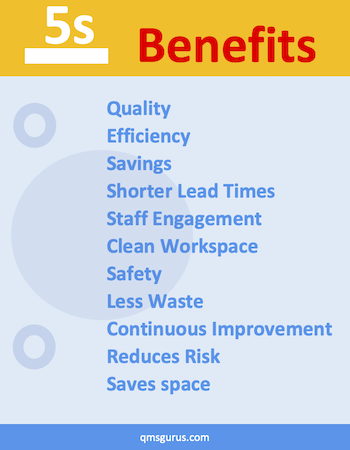
5S can deliver several significant benefits to an organization, including:
- Productivity and efficiency savings
- Monetary savings
- Space utilization
- Employee Engagement
- Health and safety
Despite being one of the most common lean manufacturing tools, many people still believe that 5S is merely tidying up the shop floor. However, there is a raft of benefits that an effective 5s program can deliver.
In today’s article, we will be reviewing 5s benefits, exploring what they are and how best a business can achieve them.
We’ll be covering:
- Benefits of 5s
- Clean and Organized workspace
- Improved efficiency
- Cost savings
- Improved lead time
- Staff Engagement
- Improved Quality
- Improved Safety
- Helps identify issues and areas of concern
- Removes Waste
- Enables other improvement activity
- Improves machine uptime
- Reduces Risk
- Creates more space
- Calculating benefits from 5s
- How to get the most benefits from 5s
- Issues that affect 5s benefits
Benefits of 5s
This article will focus on 5s benefits; we’re not aiming to provide a “What is 5s” – if you’re after a more detailed description of what 5s is, have a look at our What is 5s article.

If you’re looking to start your 5s program, let’s first discuss one of the fundamental misconceptions about 5s – “5S is for the shopfloor.”
If you’re looking to maximize the benefits from 5s, you must look beyond the shop floor and embrace 5s throughout the whole organization.
5s principles apply everywhere, from the production facility through to the office. If you don’t do this, your returns are not going to reach their full potential.
Let’s now look at the key benefits you can obtain through 5s,
1/ Clean and Organized workspace
The 5S process helps facilitate a clean and organized workspace.
The working environment becomes clean and uncluttered by removing unnecessary tools and equipment for the tasks being undertaken.
A structure is applied, and equipment is stored in methods that can drive efficiency (for example, using shadow boards).
Aside from noticeable efficiency gains, the impact this has on the workforce can enhance job satisfaction by removing unnecessary frustration.
Think for a moment, would you rather work in a clean and tidy business or one driven by disorganization and mess?
2/ Improved efficiency
Lots of time can be wasted in a business by being disorganized; consider tooling not having a designated storage area (i.e., a shadow board) the time taken to locate things prior to using them when added up can be considerable. 5S tries to resolve some of these issues by having standards to follow.
3/ Cost savings
Aligned with greater efficiency is reduced cost; if things take less time to do, then they should cost less (or you produce more or both). Efficiency drives productivity.
One of the challenges of running a 5s program is there is often a requirement to predict the returns or Return on Investment. Changes as a result of 5s are often incremental when taken in isolation. One key to this is having robust metrics (a baseline) which is in place prior to the program, which you can then use to demonstrate the savings made by showing changes to recorded data.
For more information on understanding Return on Investment with a 5s program, I’d recommend you take a look at Jon Millar’s excellent piece – https://blog.gembaacademy.com/2010/01/11/whats_the_roi_of_a_5s_program/
4/ Improved lead time
5s can have a direct impact on improving Lead time. This is achieved by:
- Creating efficiencies through being more organized
- Reducing setup times through improved layouts
- Reducing delays (i.e., removing the occurrence of missing tooling)
- Quicker changeover times (through a more organized environment)
Tip: Capture the performance prior to 5s so that you are able to measure its impact.
5/ Staff Engagement
As we’ve discussed with sufficient training, all staff can be involved with 5S. This can drive significant levels of staff engagement, which in turn can impact staff morale and contribution to the overall continuous improvement plan within the organization.
6/ Improved Quality
A key goal in any 5s deployment should be an improvement in quality and right first time.
5s can deliver benefits on quality through:
- Standard methods of working
- Highlighting defects
- Removing the root causes for defects
- Creating an environment where there is greater focus and ownership on quality by operators
7/ Improved Safety
Poor Housekeeping & ergonomics can result in safety issues within the workplace, i.e., spills that are not cleaned can create slip hazards, waste can create fire hazards.
5s can improve safety standards through two primary mechanisms:
- Removing hazards through housekeeping
- Standardized processes reducing the likelihood of incidents
8/ Helps identify issues and areas of concern
In executing 5s principles, other inefficiencies or issues can be highlighted which would not have otherwise come to light, allowing the business to undertake improvement activities to resolve them.
9/ Removes Waste
5S helps by identifying other waste within the organization’s processes (for this, consider the seven wastes). Once they’ve been highlighted, your team can then create improvement projects.
9/ 5s Enables other improvement activity
When constructing the organization’s 5S activities, thought should be given in how they can facilitate or support other supplementary Lean activities.
5s should not be thought of in isolation but rather as a support task that underpins a drive to Quality.
10/ Improves machine uptime
Resolving irregularities through a standard routine incorporating fixing and cleaning can help significantly improve equipment reliability and uptime.
How much, well, that will depend on the equipment and the processes used, but we’ve seen figures of 40-60% used as indicative, and if you have KPI’s in place already, then it’s certainly something that you can measure post 5s deployment to see the impact.
11/ Reduces Risk
5s can have a significant impact on reducing risk. It does this through
- Improving uptime
- Removing inefficiencies
- Improving Health & Safety
- Highlighting issues before they materialize
13/ Creates more space
The 5s process can help deliver more space by improving the storage of equipment, removing unnecessary tools and equipment that are not needed, and helping to optimize layouts.
On top of these quantifiable improvements, 5s has further advantages in that it is:
- Simple – While it might require an experienced individual to explain the process, once established, it is easy to deploy and maintain
- Offers improvement throughout the business – The principles of 5s can be applied throughout the business.
Calculating benefits from implementing 5s
If you research productivity gains through 5s, you’ll see various figures suggested (https://leanmanufacturingtools.org/194/benefits-of-implementing-the-5s-process/,https://toughnickel.com/business/5S_Lean, https://www.heattreat.net/blogs/tom-morrison/2017/05/25/the-importance-of-5s-in-lean all talk of figures in the 30% productivity improvement).
While there are some obvious benefits that can be readily calculated (i.e., reduction in health & safety incidences), In truth, calculating returns on 5s can be challenging (check out this great piece https://blog.gembaacademy.com/2010/01/11/whats_the_roi_of_a_5s_program/ regarding thoughts about 5S ROI).
One key tip is to have a baseline to compare against so having some numbers from pre 5s to compare to post 5s is vital.
Despite implementation being fairly simple, one of the central points of 5s is that it is part of a lean toolset and, as such, is not intended to be deployed on its own. An analogy would be like creating a fantastic production facility but forgetting the tools.
5S is part of a Lean management system, not a Lean management system in its own right, and its true benefits should be seen in that light.
How to get the most benefits from 5S

So given the possible benefits within your grasp, what are the key areas that you need to consider to support you in reaching your goals? I would consider these five key points:
- Train & Engage staff
- Focus on sustainment
- Measure the benefits and celebrate small victories
- Don’t use in isolation
- Ensure that the leadership embrace the principle
Issues that can affect 5s benefits
Even though 5S is reasonably easy and quick to implement, there are still challenges to be aware of when implementing.
The following can affect benefits realization to some degree:
1/ It is not free
Many organizations mistake the simplicity of 5s as an indicator that it doesn’t cost anything to deliver it. This is a fallacy, and whilst there are likely to be a variety of benefits delivered, an organization should provide sufficient budget to deliver it properly.
For example:
- Training – While 5S is relatively simple to implement, it is probably initially best established by an expert. This expert can then train other members of the organization and its use and deployment.
- Materials to facilitate 5s tasks
- Resources & time to undertake the activity
2/ Lack of senior support
This issue is not unique to 5s; any project or program must have sufficient backing from the top in order for it to be a success.
Some of the issues which prevent effective buy-in include:
- A general lack of understanding regarding 5s principles
- Uncertainty about ROI
- Conflicting priorities
3/ Lack of sustainment
Perhaps the number one issue. So many businesses that look to deliver 5S have a fantastic start to the program only to watch it taper off as interest wanes, and other priorities emerge. The lack of sustainment sees old habits reintroduced and benefits impacted.
4/ Poor implementation
Just because 5S is a relatively simple initiative, delivering it in the right way still takes planning, resource, and know-how. A failure to have any of these can impact the level of benefit received or, worst-case impact, the value of the program itself.
5/ A failure to deploy throughout the business
Another common issue is that 5S only gets deployed in certain functions within the business, for example, production. While this does not negate the benefits in this area, it does prevent the wider benefits that could be enjoyed through a full rollout.
6/ A failure to track the impact
Finally, a failure to track the befits of the program through utilizing a baseline, KPI’s and performance tracking can render the actual benefits (including ROI) fuzzy. The impact of this is to diminish possible improvements and being able to effectively communicate the actual benefits of the program to seniors.
Summary
5S is one of the fundamental tools of lean and can deliver a variety of benefits to a company that implements it.
However, it is not a fire and forget tool, and careful consideration of its deployment and sustainment is required.
Have you used 5S within your business? What benefits have you seen? How have you tracked them?
We would love to hear your feedback.
This article is part of our Lean Guide
·
